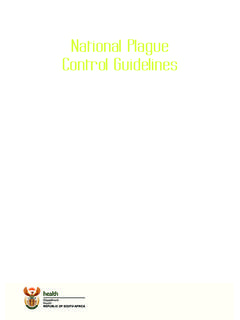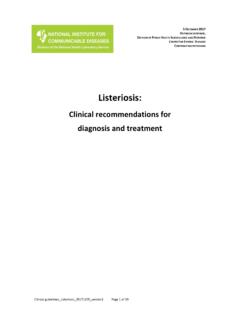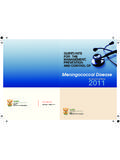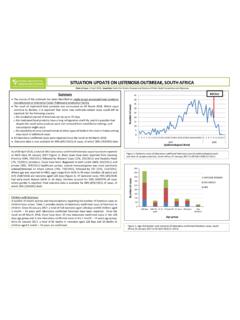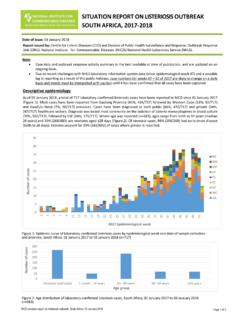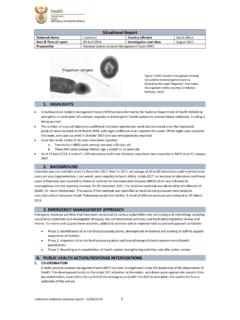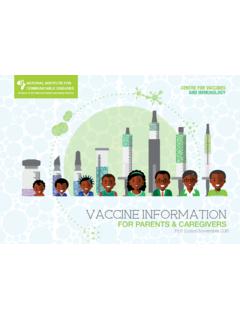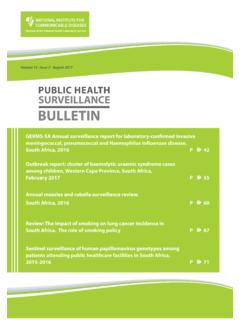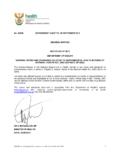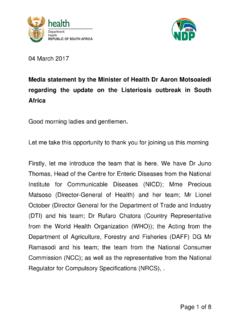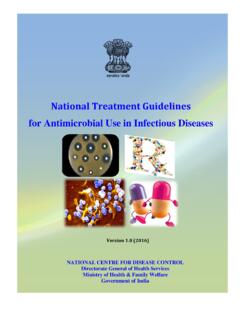Transcription of CONTENTS PAGE Editor’s Note
1 December 2021, Vol. 20 (12)COMMUNIQU Editor s NoteDecember has thus far proven to be a COVID-19 rollercoaster ride, with laboratory-confirmed cases increasing at an unprecedented rate, initially in Gauteng and soon spreading to the other provinces. There is, however, some light at the end of the tunnel as case numbers have started to decrease in Gauteng and early data are showing that hospitalisations and deaths are not increasing at the same rate as cases. Among hospitalised individuals testing positive for COVID-19, there CONTENTSDr Michelle Groomeseems to be decreased need for oxygen, ventilation and ICU, as well as a shorter hospital stay.
2 Both prior infection and increasing vaccine coverage seem to be protecting us against severe COVID-19 disease. Thankfully we have managed to avoid tighter local restrictions although the travel bans have had dire consequences especially on our tourism sector. Public health interventions are still important we need to increase our vaccine coverage, continue with the wearing of masks, social distancing, and limiting the number of people gathering indoors. DATCOV-Gen is a prospective surveillance network linking real-time SARS-CoV-2 genome data to detailed epidemiologic and clinical data on hospitalised cases to allow rapid assessment of severity and clinical presentation of emerging SARS-CoV-2 variants.
3 Read about the study which assessed the severity of Omicron infections compared to Delta variant using S-Gene target failure as a proxy at You can keep up to date with information regarding the 4th wave through our daily and weekly reports on the NICD website ( ). In this month s Communiqu , we provide updates on rabies, malaria and influenza in South Africa, Ebola virus disease in the DRC, and international diseases of concern. Have a blessed festive season and best wishes for 2022 from all of us at the AND VECTOR-BORNE DISEASESAn update on rabies in South Africa 22 INTERNATIONAL OUTBREAKS OF IMPORTANCEAn update on Ebola virus disease outbreak, Democratic Republic of Congo33 SEASONAL DISEASES Influenza Influenza activity continues4 malaria Highlights from the WHO World malaria Report, 202154 BEYOND OUR BORDERS Ross River fever Queensland, Australia6 Onchocerciasis Uganda 6 Rift Valley fever Senegal 75 WHO-AFRO.
4 OUTBREAKS AND EMERGENCIES 8 Communicable Diseases Communiqu December 2021, Vol. 20 (12)2 ZOONOTIC AND VECTOR-BORNE DISEASESAn update on rabies in South Africa, 2021 Source: Centre for Emerging Zoonotic and Parasitic Diseases, NICD-NHLS; ZOONOTIC AND VECTOR-BORNE DISEASESAs of 14 December 2021, a total of 19 laboratory-confirmed human rabies cases has been reported in South Africa for 2021 (Figure 1).
5 The cases are from Eastern Cape (n=9), KwaZulu-Natal (n=6) and Limpopo (n=4) provinces. In addition, four probable rabies cases were reported from KwaZulu-Natal (n=3) and the Eastern Cape (n=1) provinces. A probable case of rabies is defined as a person who has had a history of contact with a suspected or confirmed rabid animal and has developed an acute encephalitis with hyperactivity and paralytic signs and symptoms that progressed and resulted in death, usually by cardiac or respiratory failure, typically within ten the previous NICD Communiqu report, three cases of human rabies were reported (these cases are included in the total provided above).
6 Two cases were laboratory confirmed whilst a third is reported as probable. The confirmed cases were reported from KwaZulu-Natal Province (n=2). The first case involved a 10-year-old boy from eThekwini, reporting a dog bite on the leg in August 2021. The second case involved an 11-year-old boy, also from eThekwini. No dog bites or other animal exposures were reported in this case, but the area is amidst a marked outbreak of rabies in dogs. Both cases were confirmed by RT-PCR on ante-mortem collected saliva samples.
7 The third case, categorized as a probable rabies case, involved a four-year-old child from Mapuzi, Mqanduli, OR Tambo District, Eastern Cape Province. The child was exposed to a dog at his grandparent s home. It is reported that no post-exposure management was sought, and only wound cleaning was done at home. The child died in November 2021 following clinical diagnosis of rabies. No samples were available for laboratory is preventable in humans with prompt rabies post-exposure prophylaxis (PEP).1 For the 23 rabies cases (19 laboratory-confirmed and 4 probable) reported in 2021 to date, several issues in the delivery of rabies PEP were noted.
8 For 14 cases ( ) apparently, no post-exposure intervention was sought. For nine cases, about a third of cases, post-exposure intervention was noted, but with deviation from recommendations:1-3 no rabies immunoglobulin (RIG) provided and series of four vaccinations not completed (n=3, ); no RIG but full course of vaccination (n=1, ); or received RIG but not full course of vaccination (n=2, ). For three cases ( ) both RIG and full course of vaccination was provided; for two of these cases, facial wounds were reported. For most cases, the course on wound treatment was not available for analysis.
9 Rabies PEP is considered a lifesaving intervention when provided appropriately and according to international Wound treatment , including copious washing of all wounds with soap and water, is important to physically and chemically remove virus from the wound This can be performed at home and then repeated at the health care facility. Rabies vaccination should be provided intramuscularly with one dose administered each on days 0, 3, 7 and ,3 Follow-up strategies are important to ensure that patients do not default the full course of vaccination.
10 The administration of RIG is crucial in providing neutralization of virus present in and around the wound site whilst the immune response is activated following vaccination. The RIG should be infiltrated, up to the maximum calculated dosage, in and around the wound site/s, ensuring that all wound sites receive ,3 In some cases, sedation/general anaesthesia may be required in order to facilitate proper NICD website, , has more information on rabies and rabies Health Organization. Rabies vaccines: WHO position paper April 2018.
